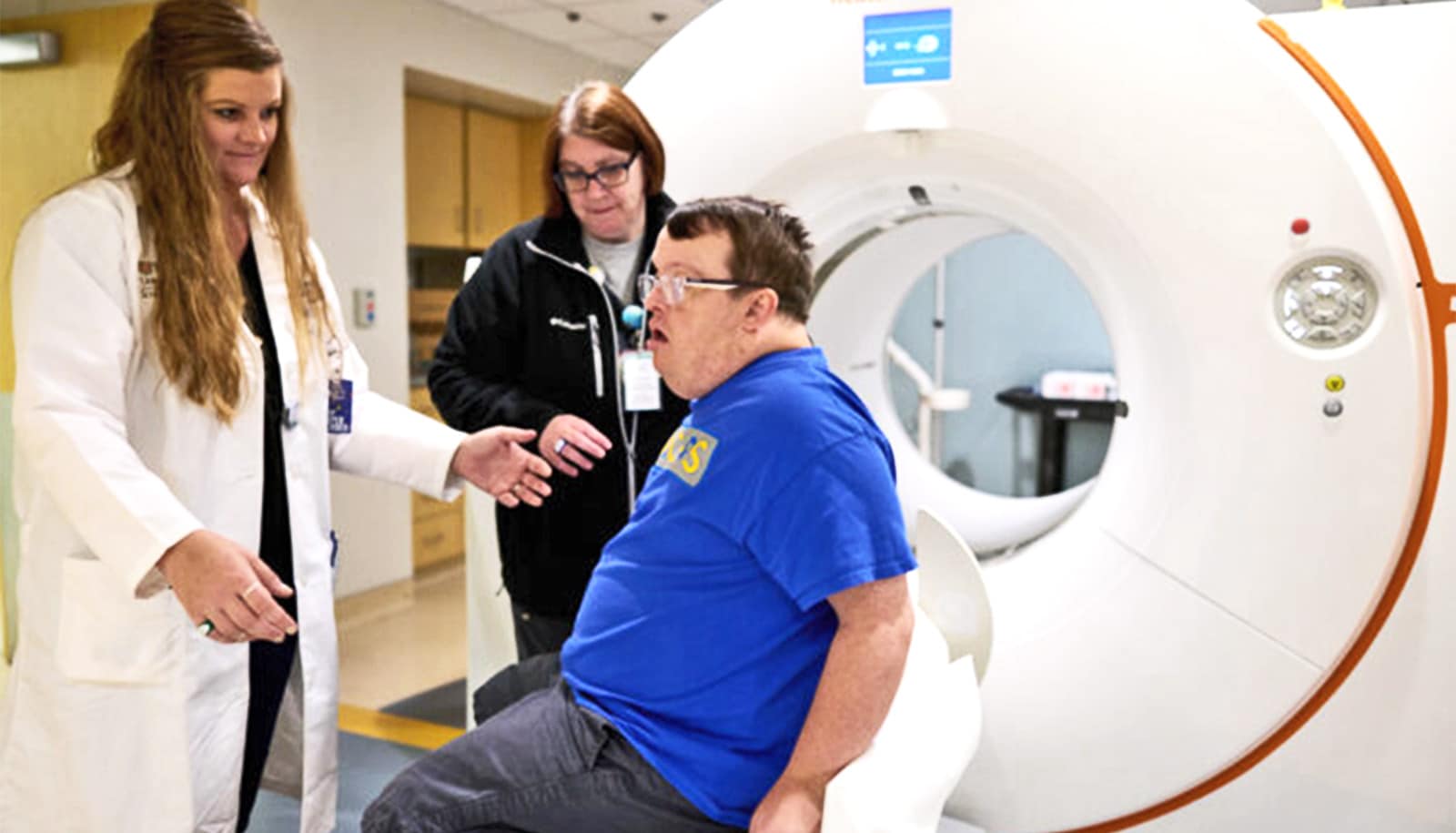A new study shows that Alzheimer’s disease both starts earlier and moves faster in people with Down syndrome,
The finding may have important implications for the treatment and care of this vulnerable group of patients.
Nearly all adults with Down syndrome will develop evidence of Alzheimer’s disease by late middle age.
The new findings were part of a study in Lancet Neurology comparing how Alzheimer’s develops and progresses in two genetic forms of the disease: a familial form known as autosomal-dominant Alzheimer’s disease, and Down syndrome-linked Alzheimer’s.
“Currently, no Alzheimer’s therapies are available for people with Down syndrome,” says co-senior author Beau Ances, a professor of neurology at Washington University in St. Louis. Ances, who cares for patients with Down syndrome, explains that people with the developmental disability historically have been excluded from Alzheimer’s clinical trials.
“This is a tragedy because people with Down syndrome need these therapies as much as anyone,” Ances continues.
Down syndrome is caused by the presence of an extra chromosome 21. That extra chromosome carries a copy of the APP (amyloid precursor protein) gene, meaning that people with Down syndrome produce far more amyloid deposits in their brains than is typical. Amyloid accumulation is the first step in Alzheimer’s disease. For people with Down syndrome, cognitive decline often occurs by the time they reach their 50s.
People with autosomal dominant Alzheimer’s disease also have a predictable timeline to cognitive decline. These patients inherit mutations in one of three specific genes: PSEN1, PSEN2, or APP. They tend to develop cognitive symptoms at the same age as did their parents: in their 50s, 40s, or even 30s.
“Since these two populations develop disease at relatively young ages, they don’t have the age-associated changes seen in most Alzheimer’s patients, who are typically over age 65,” says corresponding author Julie Wisch, a senior neuroimaging engineer in Ances’ lab. “This, combined with the well-defined age of onset in both conditions, gives us a rare opportunity to separate out the effects of Alzheimer’s disease from normal aging and expand our understanding of disease pathology.”
As part of this study, the researchers mapped the development of tau tangles, the second step in the development of Alzheimer’s disease. Using positron-emission tomography (PET) brain scans from 137 participants with Down syndrome and 49 with autosomal dominant Alzheimer’s, the researchers examined when tau tangles appeared relative to amyloid plaques and which parts of the brain were affected.
The study revealed that amyloid plaques and tau tangles—protein abnormalities that precede cognitive decline in Alzheimer’s—accumulate in the same areas of the brain and in the same sequence in both groups, broadly speaking. However, the process happens earlier and more quickly in people with Down syndrome, and the levels of tau are greater for a given level of amyloid.
“Normal progression with Alzheimer’s is that you see amyloid, and then you get tau—and this happens five to seven years apart—and then neurodegeneration,” Wisch explains. “With Down syndrome, the amyloid and tau buildup happen at nearly the same time.”
There is currently only one treatment for Alzheimer’s disease approved by the Food and Drug Administration (FDA) and proven to change the course of the disease: lecanemab, which targets amyloid. Since amyloid accumulation is the first step in the disease, lecanemab is recommended for people in early stages of Alzheimer’s, with very mild or mild symptoms. Therapies targeting tau are also under development, aimed at people in later stages of the disease, when tau pathology plays a more prominent role.
“Since there is a compression of the amyloid and the tau phases of the disease for people with Down syndrome-associated Alzheimer’s, we will need to target both amyloid and tau,” Ances says. “We may need to come up with different approaches for this population.”
This paper is part of a collaboration between two major research consortia: the Dominantly Inherited Alzheimer Network (DIAN), an international network led by Washington University to study autosomal dominant Alzheimer’s; and the national Alzheimer’s Biomarker Consortium-Down Syndrome (ABC-DS), of which Washington University is a part. Ances leads a project within the ABC-DS to map the molecular changes that occur in the brain as Alzheimer’s develops in people with Down syndrome.
“This is the third paper that has come out of this longstanding collaboration between these two giant consortiums,” says co-senior author Brian A. Gordon, an assistant professor of radiology at Washington University’s Mallinckrodt Institute of Radiology and an assistant professor of psychological & brain sciences. “By studying how Alzheimer’s develops in these two unique populations, we are building a more detailed and nuanced understanding of Alzheimer’s pathology that could lead to better diagnostics and therapies for people with any form of the disease.”
Support for the project came from the ABC–DS, funded by the National Institute on Aging and the Eunice Kennedy Shriver National Institute of Child Health and Human Development; DIAN, funded by the National Institute on Aging; the Alzheimer’s Association; German Center for Neurodegenerative Diseases; Raul Carrea Institute for Neurological Research; Japan Agency for Medical Research and Development; Korea Health Industry Development Institute; Spanish Institute of Health Carlos III; Canadian Institutes of Health Research; Canadian Consortium of Neurodegeneration and Aging; Brain Canada Foundation; Fonds de Recherche du Québec—Santé; National Institute for Health and Care Research Cambridge Biomedical Research Centre; and National Institute on Aging grants; Eli Lilly and Company; F Hoffman-LaRoche; Janssen Pharmaceuticals; Avid Radiopharmaceuticals (a subsidiary of Lilly); GHR Foundation; Cogstate; Signant; Barnes-Jewish Hospital Foundation; the Paula and Rodger Riney fund; and the Daniel J Brennan MD fund.
Avid Radiopharmaceuticals enabled use of the 18F-flortaucipir tracer by providing precursor but did not provide direct funding and was not involved in data analysis or interpretation.
The content is solely the responsibility of the authors and does not necessarily represent the official views of the NIH.



